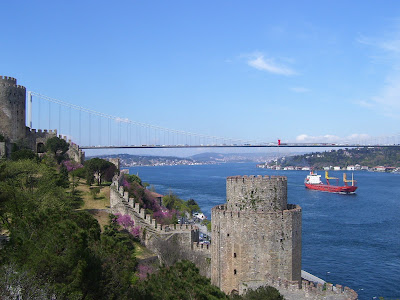
Turkey was surprisingly blue. As we crossed the country from east to west, there were the strikingly pale blue eyes of its 20th century founder, Ataturk, staring out from posters and banners, as discussed in the previous blog entry. Once we reached Istanbul and the Bosphorus, where east meets west, there was the shock of how blue the waters looked in the strait that separates Europe and Asia.

I'd read about all of the oil tankers in the Bosphorus, making me think the water might be the mucky muddy color of the Mississippi near New Orleans. Instead, the towns along the Bosphorus reminded me Italy and California. That part of Turkey is one of the places where people know what to do with a good climate and a great view. The streets closest to the water were lined with outdoor restaurants in all of the little towns we visited along the Bosporus.
We watched the tankers glide down the Bosphorus. They were almost hypnotizing, these giant ships.

Mansions from the heyday of the Ottoman Empire line the strait. Many look as though they have been renovated in recent years, a very likely scenario given the country's relative wealth generated at least in part by Germany. Turks work in Germany and send money home. Germans visit Turkey and spend.




See the castle above? Called Rumelihisari, it allowed the Turks to take Constantinople after decades of trying. Sultan Mehmet II had it built in four months in 1452. The Ottomans thrived in those days by drawing on the talents on people other than Turks. It drew its soldiers from Christian nations. Armenians held top posts in the 19th century government. Constantinople, renamed as Istanbul, prospered through the efforts of Greek merchants.
We were hearing rumblings about the U.S. immigration debate during our trip. The Ottoman Empire prospered when it had a good mix of people. When the Spanish monarchy exiled the Jewish people of Spain around the turn of the 15th century, Mehmet II's son Beyazit II sent ships to bring the refugees to his empire. Many of the important Ottoman Empire's ministers, if not most, were not Turkish Muslims. You have to wonder how much faster Turkey, a 20th century invention, would have prospered if it kept it Greek and Armenian merchants, instead of driving them away. And you have to wonder how well the U.S. would be doing if it wasn't still a Mecca for engineers, scientists and merchants as well as poorly educated people with enough drive to get across our borders.
Something Found in the Sewer
How rich was Constantinople, as Istanbul was called before Mehmet's conquest? The statue below was used in building the city's underground cisterns around the 6th century, and then this vast system of waterworks was forgotten for about a millennium. So rich you could decorate your sewers with gorgeous carvings brought from the provinces, and then let the whole system collapse.
Above are flowers in the grounds surrounding what was the White House of the Ottomans, Topkapi Palace in Istanbul. A museum today, it displays gifts the Ottomans collected over centuries. Some of the most prized gifts were Chinese porcelains. The sultans valued them far more than the ceramics of their own lands.
And, yet look at the ceramics of the Ottoman times, look at their blues.
By the end of our days in Turkey, I was thinking of things faraway too. I was a bit melancholy for a city with its own castle on the water, the little U.S. Army Corps of Engineers one near a reservoir in Washington, D.C.
It was a fine May day when I headed back home to D.C., after a stop in New York. I drove over the Chesapeake Bridge, having taken some alternate routes to avoid 95. The picture below, borrowed from a federal agency, only gives the slightest hint of how big and blue the Chesapeake looked that day, and how good it felt to be back.
(Photo courtesy of National Oceanic and Atmospheric Administration via Google Images)














No comments:
Post a Comment